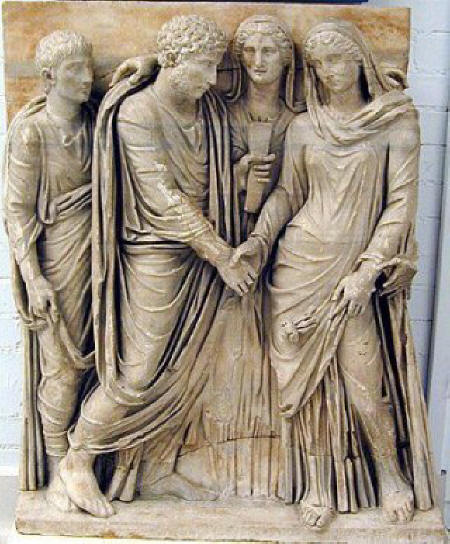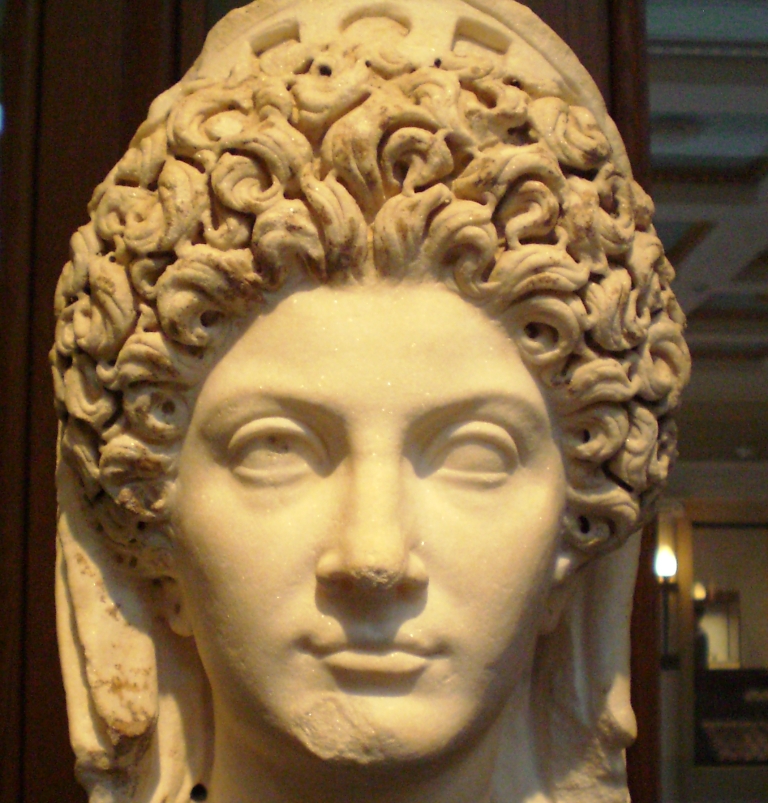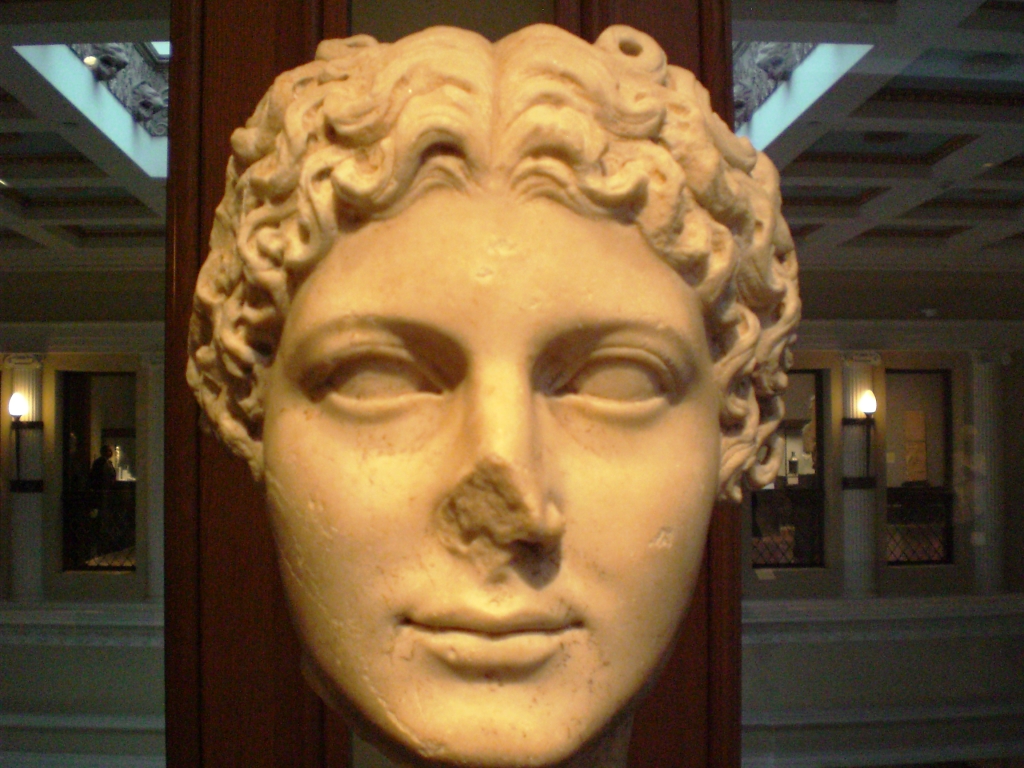|
|
| |
| |
|
|

Marriage
Ceremony: Sarcophagus. Marble. 2nd
c AD. British Museum.
Photo: B.
McManus, VRoma Project.
Highlights
* The most basic legal distinction for Roman women (and men) was free vs.
slave.
* A Roman woman always belonged to her father's family, even after
marriage.
* A Roman mother automatically lost her children to their father in the
event of divorce.
* Roman women could inherit property, have independent wealth, initiate
a divorce, and leave a will.
* Roman women could not vote, hold office, or have their own names. |
|
Women's Rights in Ancient Rome
Who were you under Roman law?
For better or worse, a
personal identity and autonomy were pretty hard to come by if you were a
Roman woman.
Take the women in Julius Caesar's
life. He had a strong mother, a beloved aunt,
a wife, a daughter, later a second wife, then a third wife, a long-time
lover, and other lovers-of-the-moment, including Cleopatra.
How much individual identity could they have outside
of marriage? Outside of the family?
|
| |
|
|
| |
|
|
Rights, Status, and Identity
Free vs. slave was the most basic legal distinction for both women and
men in the ancient world. "Freeborn" was better than a "freedman"
or "freedwoman", a slave who had been freed.
But not all women were the
same: to
be freeborn, a Roman citizen, and married was wonderful enough. To
be married to a freeborn, Roman-citizen
male, preferably rich and a member of the political and social elite, was to hit the trifecta.
Law and Property
Roman
law aimed to keep a
dynamic society as static as possible. Romans believed that a static
universe was a stable one. From stability would come wealth, power, and
the specialness that marked a Roman.
Roman law particularly aimed to
uphold the privileges and property of the family, not the individual. Birth rights, marriage, divorce,
children, inheritance--the Romans devised intricate rules to manage
them.
Different
laws applied to different status groups.
There was
no "equal
protection under the law," particularly for women.
Women
were in a special legal category, "under the protection" of a
male guardian.
|
|

Julia Titi.
Julia Titi was the daughter of Emperor Titus. Roman. Marble bust, 1st c AD. Getty Villa. |
|
|
|
|
|
|
|
|
|
|
|
|
Legal Rights of Roman Women
Roman women had no "public" rights.
They could not
-vote
-hold public office of any kind
-serve in the military
But women did have "private" legal rights. A Roman woman could
-inherit property in her own name
-own and sell her property
-get a divorce
-make a will or be the beneficiary of a will
Although legally she needed permission from her male
guardian for legal transactions, this was apparently not hard to come by.
Much changed for the worse for women during the reign of Emperor
Augustus. He sought to impose a conservative moral order, a higher birth
rate, and strict controls over the upper elite.
How did Augustus carry out his conservative program? He used legal
edicts: A woman convicted of
adultery could lose up to half her property and be banished to an
island. An adulterous wife could not remarry.
A widow must remarry
within two years. This rule was particularly onerous since so many males had been killed
in the civil wars between the death of Julius Caesar and the seizure of
power by Augustus.
A husband could not give gifts to his wife
during the man's lifetime. Elite women were supposed to learn the old
ways of weaving and spinning cloth.
|
|

Livia.
The wife of Emperor
Augustus. Roman. Marble
bust (fragmentary). Getty Villa.
Livia became independently wealthy, very wealthy indeed. She owned a
passel of properties in her own
name, through both inheritance and her own shrewdness in buying and selling.
|
|
|
|
|
|
|
|
|
|
|
|
|
What's in a name?
A woman
did not have her own full name, just the
feminine version of her father's family name. Julius Caesar's
daughter was named Julia because the family name was
Julius. Caesar's aunt was named Julia
as well.
There were loads of "Julias" in ancient Rome, members
of the Julian extended family. If there were several mother-daughter
females alive at
the same time, their names might be "Julia the Elder" and "Julia the
Younger." If there were sisters, they might be named "Julia 1", "Julia 2", and so on.
Freedwomen took the name of their patron, so they might also be
called
"Julia."
|
|

Agrippina the Younger. Marble
Bust. Roman. 1st c CE. Here's how she got her name: her father was
Marcus Vipsania Agrippa. Her mother was Agrippina the Elder. |
|
|
|
|
|
|
|
|
|
|
|
|
Who were you loyal to?
As a daughter, a Roman woman was permanently attached to
her family of birth, even after
marriage.
As a wife, she was also attached to
her husband's family.
But she could never give up the legal
connection to her father, especially in the matter of control over her dowry. A "Julia" was always going to be
"Julia," of the clan of the Julians. By the same laws, this meant the
woman's
children belonged to the husband, their father,
not to her, the mother.
Even upper class women-- rich, freeborn, Roman
citizens, beautifully adorned, like our gorgeous
Poppaea Sabina pictured right, or well-educated and talented--were perpetually stuck as
someone else's belongings.
They were just richer.
|
|

Poppaea Sabina.
The
wife of the Emperor Nero. Marble Bust, 1st c AD. National Museum of Rome, Palazzo Massimo
|
|
|
|
|
|
Updated 04-August-2015. You may contact me, Nancy Padgett, at
NJPadgett@gmail.com |
|
|
|
|
|
|
|